Month 6:10, Week 2:2 (Shanee/Matzah), Year:Day 5941:157 AM
2Exodus 4/40
Gregorian Calendar: Thursday 31 August 2017
The Hebraic Roots Bible
A Preliminary Assessment
II. The Text, Star Passages
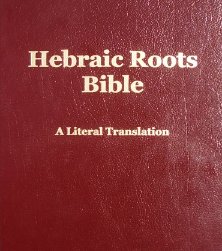
Continued from Part 1
Introduction
Had the founder of the Worldwide Church of God (WCG), Herbert W. Armstrong, become messianic, had the knowledge we possess today, and had he produced a Bible translation during his tenure as its chief (and sole) apostle, he probably would have produced something like the Hebraic Roots Bible (HRB) and probably would have resembled the latter's author, Don Esposito. The two men were, and are, very different persons, of course, so don't take the comparsion too far, but if you are to understand the doctrinal bias of Esposito, then you have to understand the teachings of the WCG itself before its successor, Tcatch, protestantised and liberalised the organisation.
Worldwide Church of God Doctrine
This is in part why, I suspect, however sincerely held the doctrinal positions may be, we find Esposito's footnotes to the HRB containing so much WCG doctrine like soul-sleeping, Binitarianism (two Persons in the Godhead - Father and Son), Saturday-sabbath, etc., remembering how Armstrong himself was influenced by the Watchtower Bible & Tract Society (WBTS) teachings, viz. the Jehovah's Witnesses. Esposito's major booklet, now in its 6th printing, The Great Falling Away, reads like a typical Armgstrongite (or Mormon or JW) tract with their bold claims of beaing the exclusive bearers of restored truth. Indeed, the more I read of Esposito's literature, the more it resembles Worldwide Church of Godism taken to the next level.
Esposito's Armstrongite Connection
Esposito was formerly, before becoming messianic, a member of the Worldwide Church of God [1] (a reason why some Armstrongite loyalists regard him as one of their own) [2], and before that a Roman Catholic. The 'evangelical salvation experience' is noticably absent in Esposito's writings, as is true of a number of contemporary messianic leaders (one of whom comes from a Jehovah's Witness background) who in my estimation are unlikely to have ever experienced the new birth. I have met a number of WCG converts from the world and it was clear to me that none had ever been born again. They reminded me of semi-messianised Jehovah's Witnesses.
We are Not Who We Were Yesterday
To be fair, Esposito may have been born-again and may have outgrown his WCG roots with its cultic spirit but I have yet to read anything he has written on the joys of salvation in Yah'shua (Jesus). We are who we are today and not who we were yesterday if the Ruach (Spirit) has been moving in our lives.
The Missing Evangelical Experience
That said, it is my experience that those coming out of cults, who have never tasted the good fruit of the 'evangelical' way of salvation (and who, as a result, tend to implaccably condemn it, as many spiritually ignorant and unregenerated messianics often do), tend to carry a lot of spiritual baggage along with them into their evolving religion unless they have undergone proper deliverance.
Not the Person But the Labour
I cannot - and will not - judge Esposito himself (since I don't know him, and even if I did, only Yahweh could ever judge the deepest places of his heart) but it is absolutely my duty to carefully examine a new Bible version, especially one presented to the world as, "THE ORIGINAL BIBLE RESTORED", and to ask questions about the author's possible biases. Since no one else seems to have seriously reviewed it that I have been able to find [3], it is high time somebody did. Last time we looked at the footnotes. This time we shall examine the text, and in particular, Esposito's personal favourites.
PART II
Review of the HRB Text's Star Passages
Esposito's Chosen Six
In the advertisement of his HRB on Don Esposito's website [4], the author lists six short extracts of his translation which we are to regard as examples of this version's superiority to others, but specifically in relation to the King James Version. Since the KJV has been 'corrected' by dozens of translations since 1611, this comparison is really only relevent as far as KJV-Onlyists are concerned. So we will compare these 'new translations' with other post-KJV Bibles - especially (but not only) messianic ones - and see if there is actually anything 'new' here, remembering that the HRB was finished/ published in 2008/9:


A Body You Have Prepared For Me
1. This rendition is based on the Septuagint (LXX) which Trimm (2004) and Koniuchowsky (2005) in their two messianic versions picked up a few years before Esposito:
"Sacrifice and meal-offering You have no delight in; a body you have clothed me with; burnt-offering and sin-offering have You not required" (HRV, 2004, fn 197, LXX) and "a body you have prepared for me" (Ps.40:6, HRV, 2004, fn 197, Münster, as quoted in Heb.10:5, HRV)
"Sacrifice and offering you did not desire, but a body You have prepared for Me..." (Ps.40:6, RSTNE2e, 2005).
"Sacrifice and offering Thou wouldst not; but a body hast Thou prepared for Me..." (LXX, 1976, Brenton trans.)
Whether Esposito picked this up from the LXX, HRV or RSTNE is not clear but he was not the first to announce this correction to the world.

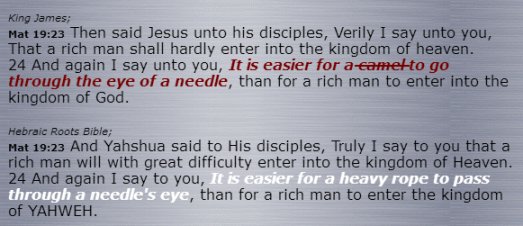
Ropes vs. Camels
2. This passage is repeated in Mark 10:25. There, as in Matthew, the translator must choose between two meanings of the same Aramaic word (gamla) which can either mean 'large rope', 'camel' or 'beam'. The erroneous Greek translation uses a Semitic loan word, kamhelos. As you will see, Esposito is not the 'discoverer' of this corrected error but James Trimm (HRV).
"Truly I tell you; It is easier to pass a large rope through the eye of a needle, than to bring the rich into the Kingdom of Heaven" (Mt.19:24, HRV, 2004).
"And again I say to you, It is easier for a large rope to go through the eye of a needle..." (Mt.19:24, RSTNE2e, 2005).
"And again I say to you that it is easier for a rope to enter into the eye of a needle..." (Mt.19:24, AENT, 2008).
"And again I tell, you, It is easier for a heavy-rope to enter through the eye of a needle..." (Mt.19:24, Katya Mattyah, 2008).

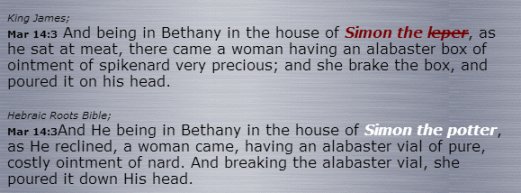
Leper vs. Potter or Jar Merchant
3. The problem with this text is that the unpointed Aramaic could either be garava ('jar-maker') or ga'rabba ('leper'). The correct choice is settled by Leviticus 13:46 since lepers were isolated from the community at large, thus making it impossible for any leper to have been entertaining non-lepers. Esposito has simply used Roth's AENT rendition.
As in the previous two samples, it is clear Esposito did not make this 'discovery' from a study of the ancient texts in their original languages. That honour falls to James Trimm in his earlier Hebraic-Roots Version (HRV):
"And while he was in Beit-Anyah in the house of Shim'on the jar merchant while eating, a woman came who had with her an alabaster jar of ointment of pistachio..." (Mk.14:3, HRV, 2004).
"And being in Beth-Anya in the bayit of Shimon the jar merchant..." (Mk.14:3, RSTNE2e, 2005).
"And while he was reclining in Beth-Anya in the house of Shimon the potter..." (Mk.14:3, AENT, 2008 - "jar maker", Introduction).

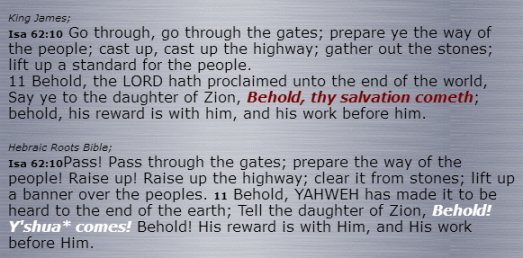
Y'shua vs. Salvation
4. The Hebrew yeshecha is properly translated "your salvation" (CJB, MATS, ATOT) or "deliverance" (ISRV, HS) and though it can mean "Yah'shua" the overwhelming consensus of scholars is that it should not be translated as a proper name and no translator (Messianic or Christian), other than Koniuchowsky and Esposito, actually do so. In that they are out on a fragile limb.
Yahweh Deliberately Hid His Son's Name
There is a reason Yah'shua's (Jesus') Name was concealed in the Tanakh (Old Testament) since Satan had been out to destroy the messianic line from the beginning. But there are plenty of clues for those possessing the Ruach (Spirit).
The Consensus is Right
My own view is the same as that of the consensus, namely, that the word here should be rendered 'salvation', 'deliverance' or 'redemption' with a footnote added clearly indicating that this is pointing to Yah'shua (Jesus) who is the 'Salvation of Yah[weh]'.
Adding to the Text Dishonestly
Esposito drops the pronoun "your" from the text, without any warranty, thus mutilating the text to make it say what he wants it to say. Koniuchowsky is at least honest enough to leave it in. Therefore we have to reject this 'star' example of a 'correct' or 'restored' Bible translation as unjustified and state categorically that is was not in the 'Original Bible'.
Better to Follow the Septuagint
Both Esposito and Koniuchowsky (RSTNE) would have done better by simply following the LXX reading, like the Eastern Orthodox Church, without pursuing sensationalism as a selling point for his book. It makes him look like a questionable used car sales merchant.
"See, YHWH has proclaimed to the end of the olam. Say to the daughter of Tsiyon, See, your Yahshua comes; see, His reward is with Him, and His work before Him" (Is.62:11, RSTNE2e, 2005).
Esposito would have done better sticking to the Septuagint:
"For behold, Yahweh (kurios, the LORD) has proclaimed to the end of the earth, say to the daughter of Zion, Behold thy Saviour (Deliverer) has come to thee..." (Is.62:11, LXX, 1976, Brenton trans.).
The Isaiah Targum Makes Plain
For confirmation that the traditional rendering is the correct one, we have only to go to the Isaiah Targum, an Aramaic paraphrase by Jonathan ben Uzziel, Rabbi Hillel's most distinguished pupil (Suk.28a; B.B.134a), a contemporary of Yah'shua (Jesus) and the apostles. What makes it particularly important is the recognition that the expected Messiah was divine, i.e. Elohim (God), a doctrine the Pharisees radically changed after they had rejected and deminised the true Messiah Yah'shua (Jesus) and set about producing a new version of the Tanakah (Old Testament) to mislead which today we know as the Masoretic Text:
"Behold, Yahweh has proclaimed unto the ends of the world, Say to the congregation of Zion, Behold, thy Redeemer shall be revealed; Behold, the reward for them that do His word is with Him: and all their works are manifest before Him" (Targum Is.62:11) [5].

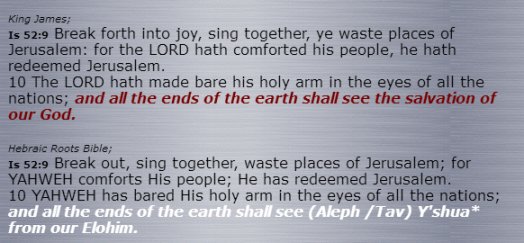
Enter the Alef-Taw's
5. The same issue arises here as with the previous passage in Isaiah 62:11 except this time there are a couple of  's or alef-taw's inserted into the text in the original Hebrew which are traditionally left untranslated because nobody knows for sure what they mean. They are found in hundreds of places throughout the Tanakh (Old Testament). 's or alef-taw's inserted into the text in the original Hebrew which are traditionally left untranslated because nobody knows for sure what they mean. They are found in hundreds of places throughout the Tanakh (Old Testament).
The Work of Riether and Sanford
Two messianic translators of the Tanakh (Old Testament), Gregory T. Riether (who produced the ATOT or Aleph-Tav Old Testament) and William H.Sanford (who produced the MATS or Messianic Aleph-Tav Scriptures) believe these two untranslated Hebrew letters are divine and/or messianic signatures or markers. You can learn more about these in our series of articles, Mystery of the Alef-Taw which, if you are not familiar with them, you should first read before going on.
"Yahweh has made bare his holy  (alef-taw) arm in the eyes of all the nations; and all the ends of the earth have seen the (alef-taw) arm in the eyes of all the nations; and all the ends of the earth have seen the  (alef-taw) salvation of our Elohim (God)" (Is.52:10, ATOT, 2012). (alef-taw) salvation of our Elohim (God)" (Is.52:10, ATOT, 2012).
Or more accurately:
"Has made bare YHWH- (alef-taw-Yahweh) His Holy Arm, in the eyes of all the nations; and shall see all the ends of the earth (alef-taw-Yahweh) His Holy Arm, in the eyes of all the nations; and shall see all the ends of the earth  (alef-taw) salvation of our Elohim (God)" (Is.52:10, MATS, 2013). (alef-taw) salvation of our Elohim (God)" (Is.52:10, MATS, 2013).
Esposito Adds Words Again
This is specifically the salvation or deliverance of Yahweh-Elohim, split into the  -Yahweh and the -Yahweh and the  -Salvation of Elohim. Esposito has started adding words again, in this case, "from" as in "from Elohim". -Salvation of Elohim. Esposito has started adding words again, in this case, "from" as in "from Elohim".
Commentary, Paraphrase or Translation?
Again, there can be little doubt that the text is pointing to the Divine Saviour or Deliverer but to actually add a Divine Name and "[from] Elohim" is putting commentary into the text. Esposito is paraphrasing. And whilst he is entitled to have that option (which I happen to believe is correct, incidentally) he is mutilating the text to say what he wants it to mean instead of simply letting it stand as it is. Again, more sensationalism. He can write what he likes, of course, but he cannot call it a 'translation', let alone a 'restoration' of the original Bible which never said these words.
HRB and RSTNE Alone
Once more, only Koniuchowsky will support Esposito up to a point, for he leaves the definite article, "the" in the text which Esposito chops out to make the text say what he wants it to say:
"YHWH has made bare His kadosh arm in the eyes of all the nations; and all the end of the olam shall see the Yahshua of our Elohim" (Is.52:10, RSTNE2e, 2005).
The Septuagint is Again Right
Again, Esposito should have stuck with the LXX:
"And Yahweh (kurios, the LORD) shall reveal His holy arm in the sight of all the nations; and all the ends of the earth shall see the salvation that comes from our Elohim (theos, God)" (Is.52:10, LXX, 1976, Brenton trans.).
and with the Isaiah Targum:
"Yahweh (the LORD) has revealed His hold arm in the eyes of all the nations; and all that are in the ends of the earth shall see the salvation of our Elohim (God)" (Targum Is.52:10) [5].

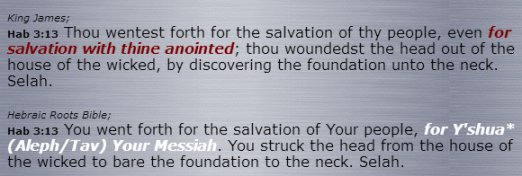
Habakkuk's Alef-Taw's
6. The next and final star translation of Esposito's constellation of six noteworthies that are advertised for his HRB is yet another (third) example of inserting Yah'shua's (Jesus') Name into the Tanakh (Old Testament) text, on this occasion from one of the so-called 'minor' nevi'im (prophets). But this time Koniuchowsky does not follow suit. On what authority does Esposito base this latest translation? Those pesky  's (alef-taw's) again! 's (alef-taw's) again!
"You went out for the salvation of your people, for the salvation of your  (alef-taw) anointed" (Hab.3:13, ATOT, 2012). (alef-taw) anointed" (Hab.3:13, ATOT, 2012).
"taxy You came out for the salvation of Your people, even for salvation with  Your anointed" (Heb.3:13, MATS, 2013) Your anointed" (Heb.3:13, MATS, 2013)
Now if Esposito had been consistent, following his own made-up 'rules' of translating 'salvation', he should have rendered the passage in this way:
"You went forth Y'shua of Your people, for Y'shua (Aleph/Tav) Your Messiah..."
Non-Sensical
But he doesn't, and understandably, because it doesn't make any sense. You can't pick and choose which 'Y'shua's' you want to put and which to leave out. That's cheating. It's bending the text to be the way you want it to be. Yes, there is a  (alef-taw) alongside the second 'salvation'. If we are only 'allowed' to insert Yah'shua's Name alongside a (alef-taw) alongside the second 'salvation'. If we are only 'allowed' to insert Yah'shua's Name alongside a  (alef-taw), why did Esposito put it in the text of Isaiah 62:10 when there was no (alef-taw), why did Esposito put it in the text of Isaiah 62:10 when there was no  (alef-taw) at all?! (alef-taw) at all?!
The Septuagint is Still Better
He should simply have translated the passage the way it is rendered in the Septuagint:
"Thou wentest forth for the salvation of thy people, to save thine anointed..." (Hab.3:13, LXX, 1976, Brenton trans.).
No Doctrinal Criticism of the Six
In none of my criticisms of these six passages am I saying that Esposito is teaching false doctrine. To the contrary, these six key passages he has selected to advertise his work are absolutely doctrinally correct. The problem is the last three don't say what he wants them to say. He has added commentary of his own.
Translating is a Great Responsibility
Someone translating the Davar Elohim (Word of God) has to be scrupulously honest because of the responsibility involved. If he is in doubt, he needs to add a footnote explaining the difficulties - as without a doubt there legitimately are sometimes - and indeed you will commonly find good translations adding the note, 'meaning uncertain' or something like that. And where more than one interpretation is possible, the good translator may pick one of his choosing provided he lists the alternatives in a note and (preferably) explains why he has made his choice.
The Concern
Here is my concern, after closely examining just six passages of the HRB: if the author is willing to go to such lengths of textual manipulation to prove a true doctrine which is hinted at but not actually there (the Name of the Saviour), what lengths might he be willing to go to in order to defend a false one? Can he be trusted? Is the scholarship rigorous enough to merit the label that this is a serious work worthy of our consideration?
Do We Need So Many Denominational Translations?
Is this just one man's doctrinal wish-fulfillment or a piece of propaganda for his group, as the leaders of new groups seem to feel pressured to produce a prophetic translation of their own with which to vindicate their calling and ministry? Must we have a new Bible version with each new denomination?
Only Two Serious Messianic Translations
I consider there to only be to date (2017) two serious Messianic Translations, both of the New Testament (HRV, AENT) alone [6] which means that for now we still need the better Protestant translations alongside.
Conclusion
As this is only a preliminary investigation, what I would like to do now is select several key passages of my own that I look at when confronted with a new translation to see whether they measure up. We will deal with these in Part 3.
Continued in Part 3
Also see Bible Versions
Endnotes
[1] Official Esposito website, section on Founder and President
[2] In commenting on the new HRB: "Why is it that everything a COG or former COG member touches has to be so earth shattering[ly] significant? We have the best prophets and apostles. We have the best biblical knowledge, we write better booklets, we do better television shows, we build better auditoriums and colleges. the list could go on and on about how we think we are God's gift to the world. Yet, if we truly were, why are there over 700 some splinter cults with 700 different opinions?" (Books, News and Observations About Armstrongism and the Churches of God)
[3] The HRB is totally omitted from Hebraic Bible reviews such as, Comparing and Reviewing Hebrew Roots Bible Translations made in 2015
[4] Congregation of YHWH Jerusalem
[5] Targum Isaiah with Parallel Jewish and Christian texts (ed. Eliyahu ben David, 2012)
[6] I exclude the Complete Jewish Bible (CJB) by David Stern because, by his own admission, this is only a cosmetic paraphrase version and in the New Testament works from Greek not Hebraic texts.
Read the Hebraic Roots Bible free (PDF file)
(This text may be downloaded but must not be altered or sold)
To buy a hardcopy, go the the
Congregation of Yahweh, Jerusalem website

| 

